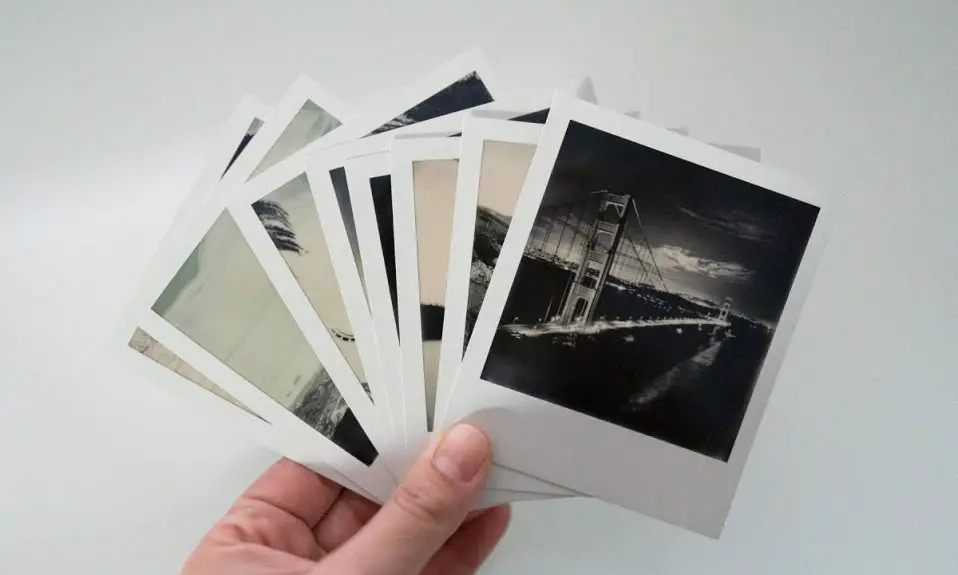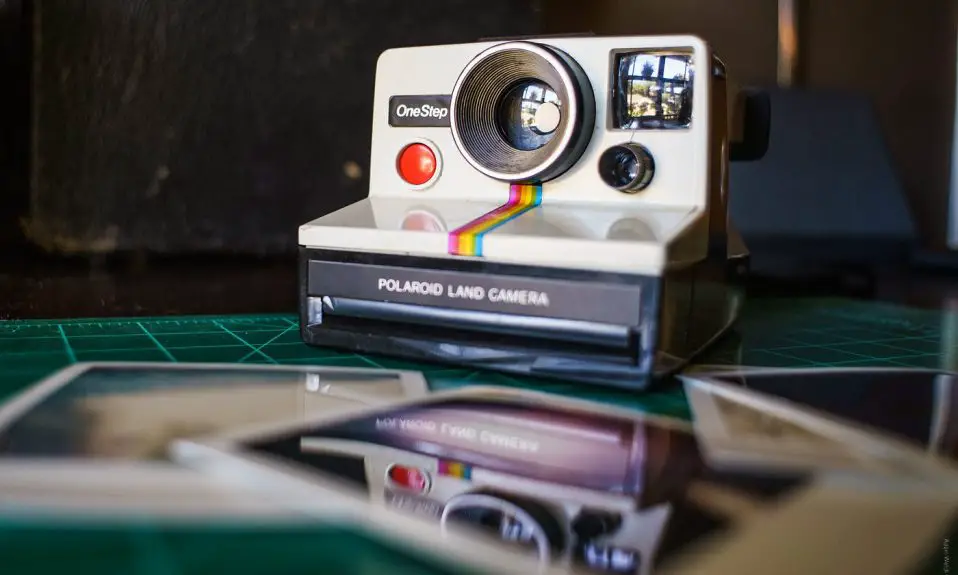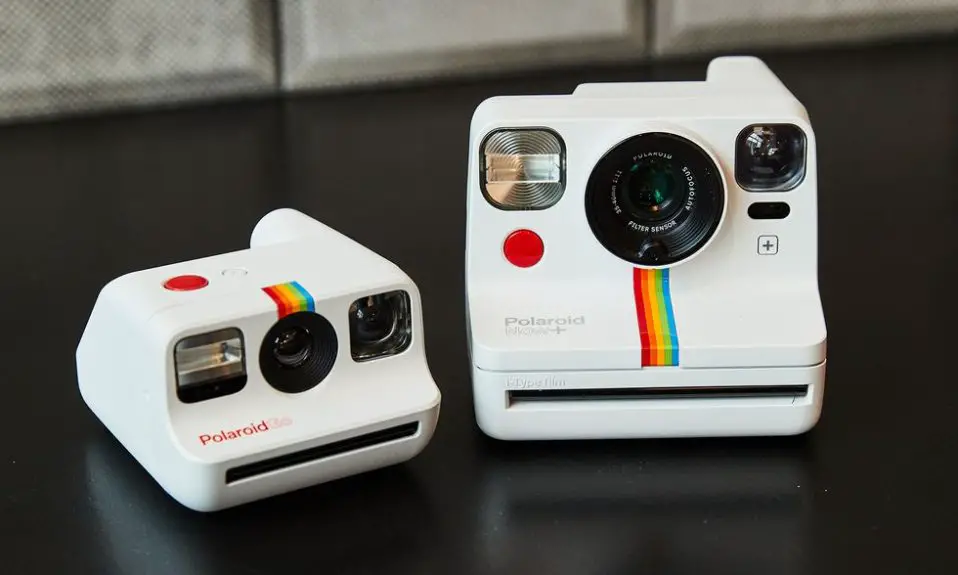Instant photography has a certain magic to it—the anticipation as an image slowly emerges on a piece of film is a unique experience.
Commonly, people associate the act of taking a Polaroid with the immediate action of shaking the photo to speed up the development process.
This practice has become so ingrained in popular culture that it’s almost a reflex for some to give that fresh Polaroid print a vigorous shake.
But is this the right thing to do?
In my experience and understanding of the film’s properties, shaking a Polaroid photo isn’t just unnecessary, but it could actually be detrimental to the picture’s quality.
The belief that shaking accelerates the development is a misconception. Polaroid’s instant film is designed to develop fully and correctly within a contained, stable environment.
The film packet contains all of the necessary chemicals, which are evenly spread across the image as it is ejected from the camera.
Shaking it could disrupt this chemical process, potentially resulting in a warped or blotchy photograph.
Contents
- The Polaroid Instant Photography Process
- Common Misconceptions About Shaking Polaroids
- The Official Stance from Polaroid on Shaking
- Alternative Methods to Ensure Photo Development
- The Impact of Shaking on Polaroid Photos
- Proper Care and Handling of Polaroid Photos
- Historical Context and Pop Culture References
- Frequently Asked Questions
- What should be done after taking a Polaroid photo to ensure best quality?
- Is shaking a Polaroid photo beneficial or harmful to the image development process?
- What effect does shaking have on the outcome of Instax film photos?
- What is the origin of the practice of shaking Polaroid pictures?
- Does the motion of shaking have any impact on Polaroid 600 film processing?
- What are the consequences of shaking a Polaroid picture in terms of image clarity?
The Polaroid Instant Photography Process
In the realm of instant photography, I will elucidate the seamless yet complex process that occurs from the moment a photo is taken with a Polaroid camera to when the image appears.
Components of a Polaroid Film
The film used in Polaroid cameras consists of key layers, each with a specific function. I’ll detail the main components:
- Negative: Contains the light-sensitive chemicals.
- Developer Sheet: Where the exposed photo appears.
- Timing Layer: Controls the development pace.
- Image Receptors: Capture the dyes that form the picture.
- Border: Serves as a protective covering as well as a space for the chemical pods.
Chemical Reactions During Development
Upon taking a photo, a sequence of chemical reactions is initiated:
- Light exposure captures the image on the film’s negative.
- The camera’s rollers compress the film, bursting the chemical pods.
- These chemicals spread between the negative and the developer sheet.
- A reagent reacts, commencing development by activating layers of color dye.
The image slowly emerges as these chemicals react and coalesce in the confines of the Polaroid film, resulting in a fully-developed photograph after a few minutes.
Common Misconceptions About Shaking Polaroids

One pervasive misconception is that shaking a Polaroid photo helps it develop faster.
This belief might stem from an urge to expedite the exciting moment of seeing a freshly captured image.
However, contrary to this popular notion, shaking does not speed up the development process. It can be harmful.
The structure of Polaroid film is quite delicate, consisting of layers that contain the necessary chemicals for image development.
When I shake a Polaroid, I risk introducing air bubbles or causing uneven spreading of the developing chemicals, which can lead to imperfections in the final photograph.
Additionally, there is a belief that shaking aids in drying the photo quicker.
However, modern Polaroid film is designed to develop and dry in a controlled manner within the film itself.
Shaking it can actually lead to smearing of the photo or introduce dust and other particles to the image surface.
Myth: Shaking a Polaroid photo speeds up development.
Reality: It may cause damage or imperfections.
Here’s a quick list to dispel the popular myths:
- Shaking does not develop the photo faster.
- Shaking can cause air bubbles and blemishes.
- The image should instead be placed face down on a flat surface to develop.
By understanding the correct handling of Polaroid film, I ensure the preservation of those special moments captured, without unintentionally damaging my keepsakes.
The Official Stance from Polaroid on Shaking
Polaroid, a leader in instant photography, has provided clear guidelines regarding the practice of shaking their instant photos.
I understand that many individuals have adopted the habit of shaking Polaroid pictures, possibly influenced by pop culture references.
However, in my research, I’ve found that Polaroid discourages this action.
Shaking the film does not aid the development process; it risks damaging the photo.
The composition of a Polaroid photo is such that the development chemicals are contained between layers of plastic.
When these photographs are shaken, air bubbles and other aberrations could potentially form, leading to an uneven distribution of the developing chemicals.
This can result in a compromised final image with streaks and blotchy areas.
Here is a brief summary:
- Shaking: Not recommended
- Reason: Potential photo damage
- Chemicals: Sealed, shaking introduces air bubbles
I advise photographers to simply lay the photo flat and allow it to develop in its own time. This method helps ensure the highest quality and clarity of the captured image.
It’s important to let nature take its course with the development of Polaroid photos; patience is key.
Alternative Methods to Ensure Photo Development
When I handle a Polaroid photo after taking it, my objective is clarity and preservation. It’s not recommended to shake the photo, as this can be harmful.
Instead, there are several approaches to ensure optimal development:
Lay it Flat: I immediately place the photo face down on a flat surface. This shields it from light and allows the chemicals to spread evenly through their own processing cycle.
Shield from Light: Protecting the photo from direct light is crucial, especially just after it exits the camera. Some photographers use a dark slide or simply turn the photo face down for a few minutes.
Handle with Care: To avoid fingerprints or damage to the developing image, I make sure to handle the edges of the photo only.
Temperature Matters: Polaroids develop best at moderate temperatures. If it’s cold, I may put the photo inside my jacket, whereas in hot conditions, finding a cool, shaded area is beneficial.
Patience is Key: Polaroids typically take about 10-15 minutes to fully develop. I don’t rush this process; instead, I give it the necessary time.
Storage:
- Short-Term: Keep the photos away from extreme conditions and sunlight.
- Long-Term: After full development, storing them in a dry, cool place protects their longevity.
These methods are reliable and safe. I follow them to ensure my Polaroid photos develop to their full potential without risking damage.
The Impact of Shaking on Polaroid Photos
When it comes to Polaroid photos, many believe that shaking the picture helps it develop faster. However, the actual effects of this practice are quite different.
Potential Harms of Shaking
Distortion and Damage: Shaking a Polaroid can cause harm to the photo’s development process. Because the image forms between two plastic layers containing reactive chemicals, agitating the photo might lead to:
- Uneven Development: Pockets of chemicals might settle incorrectly.
- Blemishes: Shaking can introduce air bubbles or streaks, resulting in marks on the final image.
What Shaking Can and Cannot Do for Polaroids
No Acceleration in Development: Polaroids are designed to develop on their own, without the need for external assistance. Shaking does not expedite this process. Contrary to popular belief, the film’s reaction is self-contained and unaffected by air exposure.
Possible Misconceptions Cleared: While the action of shaking is instinctual for many, it’s important to clarify that:
- Shaking will not prevent spots or ‘fix’ a developing photo.
- Proper Polaroid care involves laying the photo flat, face down, or in a dimly lit area, as exposure to light during development can impact the photo quality.
Proper Care and Handling of Polaroid Photos
When I handle my Polaroid photos, I am very careful to ensure their longevity and quality. Here’s a concise guide on how to manage this unique type of photo:
During Development:
- As soon as the picture ejects from the camera, avoid shaking it. Contrary to popular myth, shaking can actually be harmful.
- Place the photo face down on a flat surface or hold it by the edges, and leave it undisturbed for the development time recommended by the manufacturer.
After Development:
- Once developed, handle the photos by their edges to minimize the risk of fingerprints or smudges.
- Avoid bending or twisting the photo, as this can damage the internal chemical layers.
Storage Tips:
- Store Polaroid pictures in a cool, dry place to prevent degradation over time.
- Keep them away from direct sunlight to prevent fading.
- Use archival-quality albums or containers that are designed for photographs.
Cleaning:
- If a photo gets dusty, lightly brush it off with a soft, dry cloth.
- Do not use water or chemicals as they can damage the photo surface.
By following these simple tips, I ensure that my Polaroid photos remain in pristine condition, encapsulating those special moments without loss of quality or integrity.
Historical Context and Pop Culture References
My focus in this section is to shed light on the origins of the widespread belief that shaking Polaroid photos is beneficial and to explore its depiction in movies and music.
Origins of the Shaking Myth
The myth that shaking a Polaroid picture expedites the drying process likely stemmed from the appearance of instant film in 1948 and the subsequent color version introduced by Polaroid in 1963.
Originally, Polaroid images would be pulled apart from a roll that could be exposed to air, and users would wave or shake the photo to help it dry.
However, with advancements in film technology, particularly from the 1970s onwards, this practice became obsolete since the photos were now developed within a sealed environment.
Shaking Polaroids in Movies and Music
The act of shaking a Polaroid has been popularized and immortalized in pop culture, particularly through movies and music. In films, characters are often shown shaking a freshly taken Polaroid picture, cultivating the idea that this action is part of the process.
This representation has played a significant role in establishing and perpetuating the myth.
Furthermore, the song “Hey Ya!” by OutKast famously included the lyric “Shake it like a Polaroid picture,” which further ingrained the act into the cultural consciousness, encouraging a generation to associate Polaroids with a shaking motion.
Frequently Asked Questions
In this section, I address some common inquiries regarding the proper handling of Polaroid photos for the best outcomes.
What should be done after taking a Polaroid photo to ensure best quality?
After taking a Polaroid, I should place it face down on a flat surface and avoid bending, shaking, or exposing it to light immediately to ensure optimal image quality as it develops.
Is shaking a Polaroid photo beneficial or harmful to the image development process?
Shaking a Polaroid photo is actually harmful. It can cause uneven development, streaks or blotches, and potentially ruin the photo due to the way the chemicals are spread between the layers of the film.
What effect does shaking have on the outcome of Instax film photos?
Just like with Polaroid pictures, shaking Instax film photos can be detrimental. Instax film is designed to develop without interference, and shaking it may disrupt the development process, leading to suboptimal image quality.
What is the origin of the practice of shaking Polaroid pictures?
The practice of shaking Polaroid pictures became popularized by the OutKast song “Hey Ya!”, which included the phrase “Shake it like a Polaroid picture.” However, this was a cultural reference and not based on the manufacturer’s recommendation.
Does the motion of shaking have any impact on Polaroid 600 film processing?
Shaking Polaroid 600 film does not positively impact the processing. On the contrary, it risks damaging the photo’s development, similarly to other types of instant film.
What are the consequences of shaking a Polaroid picture in terms of image clarity?
Shaking a Polaroid picture can lead to reduced image clarity. The photo may develop with irregularities, blurring, and areas where the chemical reaction was disturbed, resulting in a lower-quality image.





